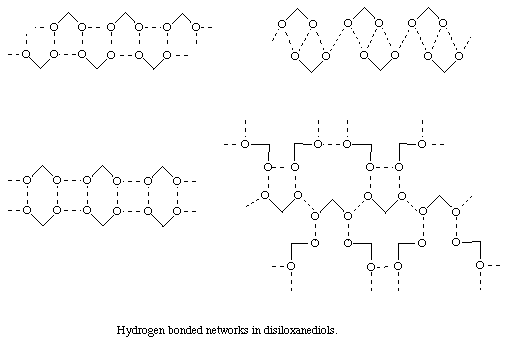
Return to Group's Home Page P. D. Lickiss - Research
Organosilicon Chemistry
Our research in the field of organosilicon chemistry falls into two main areas: silanols and siloxanes; and sterically hindered compounds.
Silanols and Siloxanes
Silanols (compounds containing the Si-OH group) are ubiquitous in nature, for example in silicic acid, Si(OH)4, found in low concentration in the aqueous environment, and on the surface of silicate rocks. The silanol group is also important in a variety of industrial situations such as the manufacture of silicones, sol-gel processes, and as silane coupling agents for use in the functionalisation of surfaces. One of the most important features of the chemistry and structure of silanols is the high acidity of the group which means that they tend to form strong hydrogen bonds both to themselves and to organic molecules containing suitable hydrogen bonding sites so as to form a wide variety of adducts (see electronic conference article for recent examples). Silanols thus form a wide range of hydrogen bonded structures ranging from simple dimers, through various types of chain and sheet, (see figure below) to extended three-dimensional networks. (See P. D. Lickiss, Adv. Inorg. Chem., 1995, 42, 147 - 262 for a review.) This area has become of greater relevance recently since it has been found that silicones are broken down to low molecular weight silanols in the environment.

We are currently investigating some of the features of silanol chemistry in an EPSRC sponsored CASE project with the Dow Corning Corporation (work carried out by Lisa Cother) and also the potential of R2Si(OH)2 and RSi(OH)3 species for the preparation of metallasiloxane species (work carried out by EC funded postdoctoral research fellow Dr Guilaine Veneziani). Another project initiated recently, funded by the EPSRC Nanotechnology Initiative, and jointly supervised by Dr Richard Templer, involves the synthesis of siloxane monomers for insertion into lyotropic liquid crystals (work carried out by Chris Yates).
Previous work in the area of silsesquioxanes was carried out (by Dr Harjit Kaur) as part of an SERC CASE award sponsored by the Brewing Research Foundation.
Recent publications from the group in this field are numbers 91, 87, 85, 84, 73 and 72 on the Lickiss Publications page.
Sterically Hindered Compounds
Organosilicon compounds containing bulky groups such as (Me3Si)3C, (PhMe2Si)3C or (Me3Si)3Si often exhibit unusual reactivity and have novel structures because of the severe steric hindrance produced at centres to which they are attached. For example, the trichlorosilane (Me3Si)3CSiCl3 is very resistant towards hydrolysis, and the silanetriol (Me3Si)3CSi(OH)3 is stable towards self condensation reactions and forms a hydrogen bonded hexameric cage in the solid state. Current work is directed towards the possibility of stabilising silylium ions (R3Si+ species) with the bulky group, for example, by abstraction of the hydride in (Me3Si)3CSiMe2H, and also the stabilisation of compounds containing multiple bonds to silicon such as silenes and silanones. This work is being carried out by a Commonwealth Scholar, Phindile Masangane.
Previous work in this area has been carried out by Dr Youcef Derouiche [(Me3Si)3Si containing compounds), Dr Steve Whittaker [cationic rearrangements of (Me3Si)3C containing compounds], and Dr Colin Smith (bulky silyl lithium reagents and oligosilanes).
Recent publications in this field are numbers 89, 87, 82, 79, 76 and 75 on the Lickiss Publications page.
Sonochemistry
As well as its more familiar uses, for example in medicine where it is used in foetal imaging and in physiotherapy, ultrasound (commonly in the range 20 - 100 kHz) has recently been widely used as a helpful tool in the laboratory. The technique relies on the phenomenon of cavitation, microscopic bubbles form and collapse generating very high local temperatures and pressures together with microstreaming to surfaces. These effects can be used in both homogeneous and heterogeneous systems. We have been investigating possible dosimeters for ultrasound and the use of ultrasound for organometallic and inorganic synthesis.
Previous work on the generation of nitrite, nitrate etc. and dosimetry was carried out by Dr Carole Wakeford. Work on organometallic synthesis of silicon and tin compounds in particular, was carried out by Dr Ronan Lucas. For example, the transformation of silica to the tris catecholate complex below occurs rapidly and cleanly at room temperature under ultrasonic irradiation.

Recent publications in this field are numbers 90, 85, 83, 81, and 80 on the Lickiss Publications page.
Photovoltaic Materials
We are interested in the synthesis and use of CVD precursors to photovoltaic materials, in particular the ternary material CuInxGa(1-x)Se2. This work is carried out in collaboration with Dr. R. D. Pilkington and Dr R. D. Tomlinson of the Department of Electronic Engineering at the University of Salford. The work was supported under the SERC 21st Century Materials Initiative and postdoctoral workers Andrew Jackson and Dipti Shah worked on the project.
Recent publications in this field are numbers 68, 66, 61, and 60 on the Lickiss Publications page.
Go to Lickiss Publications Go to Lickiss CV Go to Lickiss Teaching